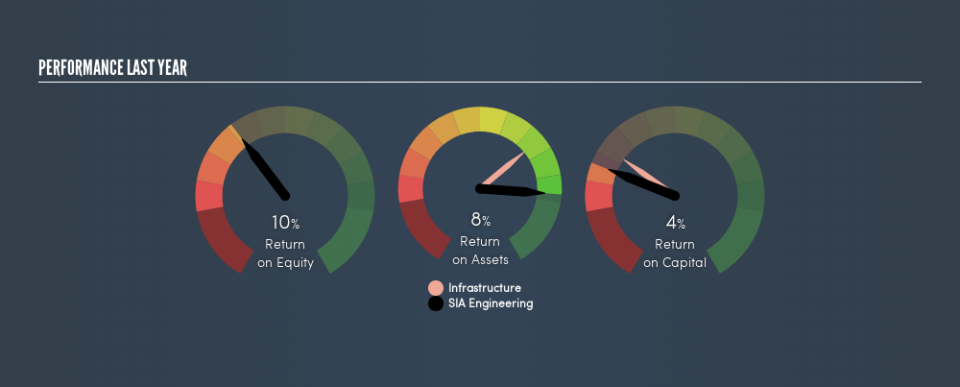Why SIA Engineering Company Limited’s (SGX:S59) Return On Capital Employed Might Be A Concern

Today we are going to look at SIA Engineering Company Limited (SGX:S59) to see whether it might be an attractive investment prospect. Specifically, we'll consider its Return On Capital Employed (ROCE), since that will give us an insight into how efficiently the business can generate profits from the capital it requires.
First, we'll go over how we calculate ROCE. Next, we'll compare it to others in its industry. And finally, we'll look at how its current liabilities are impacting its ROCE.
Understanding Return On Capital Employed (ROCE)
ROCE is a measure of a company's yearly pre-tax profit (its return), relative to the capital employed in the business. All else being equal, a better business will have a higher ROCE. Overall, it is a valuable metric that has its flaws. Renowned investment researcher Michael Mauboussin has suggested that a high ROCE can indicate that 'one dollar invested in the company generates value of more than one dollar'.
So, How Do We Calculate ROCE?
Analysts use this formula to calculate return on capital employed:
Return on Capital Employed = Earnings Before Interest and Tax (EBIT) ÷ (Total Assets - Current Liabilities)
Or for SIA Engineering:
0.038 = S$66m ÷ (S$2.0b - S$267m) (Based on the trailing twelve months to June 2019.)
So, SIA Engineering has an ROCE of 3.8%.
View our latest analysis for SIA Engineering
Does SIA Engineering Have A Good ROCE?
When making comparisons between similar businesses, investors may find ROCE useful. We can see SIA Engineering's ROCE is meaningfully below the Infrastructure industry average of 7.1%. This performance could be negative if sustained, as it suggests the business may underperform its industry. Independently of how SIA Engineering compares to its industry, its ROCE in absolute terms is low; especially compared to the ~2.3% available in government bonds. There are potentially more appealing investments elsewhere.
SIA Engineering's current ROCE of 3.8% is lower than its ROCE in the past, which was 5.4%, 3 years ago. This makes us wonder if the business is facing new challenges. You can click on the image below to see (in greater detail) how SIA Engineering's past growth compares to other companies.
Remember that this metric is backwards looking - it shows what has happened in the past, and does not accurately predict the future. ROCE can be deceptive for cyclical businesses, as returns can look incredible in boom times, and terribly low in downturns. ROCE is, after all, simply a snap shot of a single year. Since the future is so important for investors, you should check out our free report on analyst forecasts for SIA Engineering.
What Are Current Liabilities, And How Do They Affect SIA Engineering's ROCE?
Short term (or current) liabilities, are things like supplier invoices, overdrafts, or tax bills that need to be paid within 12 months. Due to the way the ROCE equation works, having large bills due in the near term can make it look as though a company has less capital employed, and thus a higher ROCE than usual. To counteract this, we check if a company has high current liabilities, relative to its total assets.
SIA Engineering has total liabilities of S$267m and total assets of S$2.0b. Therefore its current liabilities are equivalent to approximately 13% of its total assets. With a very reasonable level of current liabilities, so the impact on ROCE is fairly minimal.
Our Take On SIA Engineering's ROCE
That's not a bad thing, however SIA Engineering has a weak ROCE and may not be an attractive investment. But note: make sure you look for a great company, not just the first idea you come across. So take a peek at this free list of interesting companies with strong recent earnings growth (and a P/E ratio below 20).
For those who like to find winning investments this free list of growing companies with recent insider purchasing, could be just the ticket.
We aim to bring you long-term focused research analysis driven by fundamental data. Note that our analysis may not factor in the latest price-sensitive company announcements or qualitative material.
If you spot an error that warrants correction, please contact the editor at editorial-team@simplywallst.com. This article by Simply Wall St is general in nature. It does not constitute a recommendation to buy or sell any stock, and does not take account of your objectives, or your financial situation. Simply Wall St has no position in the stocks mentioned. Thank you for reading.

